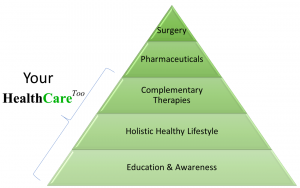The Triple Aim

The recent “Scorecard” from the Commonwealth Fund Commission on a High Performance Health System gives the U.S. health care system an overall score of 66 percent, with 100 percent referring to the top decile of known performance. The commission notes that even though U.S. health care expenditures are far higher than those of other developed countries, our results are no better. Despite spending on health care being nearly double that of the next most costly nation, the United States ranks thirty-first among nations on life expectancy, thirty-sixth on infant mortality, twenty-eighth on male healthy life expectancy, and twenty-ninth on female healthy life expectancy.
The Triple Aim has been widely-adopted throughout the US “health care” system and has served as the foundations for such improvement efforts as the Patient Centered Medical Home (PCMH), Population Health Management, Value Based Care and more. The Triple Aim simply calls for:
- improving the individual experience of care;
- improving the health of populations;
- reducing the per capita costs of care for populations.
Ten Years Later
Let’s take a quick look at the numbers in the Triple Aim’s original 2008 article and see what has happened a decade later:
- the United States ranks thirty-first among nations on life expectancy… now 39th
- thirty-sixth on infant mortality… now 40th
- twenty-eighth on male healthy life expectancy… now 39th
- twenty-ninth on female healthy life expectancy… now 41st
What about the Triple Aim itself?
- improving the individual experience of care. Despite the new Amazon-Berkshire-Chase venture and recent political challenges, it’s hard to get a good answer on this. Let’s be positive and go with the OECD’s published study and say American attitude toward the “health care” system is the same in 2017 as 2007.
- improving the health of populations. There may be some exceptions for particularly well-defined populations; however, the evidence points to worse health in the US, from infant mortality to life expectancy.
- reducing the per capita costs of care for populations. Not even close. The US spends more per capita now than in 2008, even after adjusting for inflation. The share of GDP that “health care” consumes also continues to rise.
After a decade the Triple Aim has not moved the needle on anything. This is not to say that the Triple Aim is a bad idea (or the Quadruple Aim where we include the wellbeing of clinicians as another Aim). In fact, the Triple Aim has lasted so long because it is a good idea. The Triple Aim is simply impractical for a “health care” system that is really a sick care system. However, claiming that the Triple Aim is front and center has been a magnificent bluff for the status quo sick care.
Sick Care
Sick Care is for the sick… only. There is (with a few exceptions) no reimbursement to keep you healthy. To get paid in the sick care system, clinicians must 1) diagnose you with an appropriate malady (and assign the appropriate ICD10 codes) and 2) provide appropriate treatment for the malady (and submit appropriate CPT or HCPCS billing codes). No diagnosis = no treatment = no payment. Even if the clinician dutiful jumps through all the coding hoops, the payer might still decline payment. There is no money for health care, only “sick care” or “disease management” or “acute care” or something else that requires illness.
The origins of our sick care system are rooted in a time when the need for acute care truly made more sense. Here is a recent article with more thoughts on acute care’s roots.
Now let’s think about the Triple Aim in terms of the sick care model:
- improving the individual experience of care. No one wants to be a patient. Everyone wants to be healthy. The best individual experience possible is to avoid sick care. The next best is to make any interaction with sick care as brief as possible. There is no money for sick care (i.e., hospitals, clinicians, pharmaceuticals and medical devices, etc.) from healthy people.
- reducing the per capita costs of care for populations. What is the incentive in a sick care system to reduce the per capita costs? While many hospitals added billions to the bottom line from Wall Street, they still need patients for revenue and with low margins they need more patients and treatments in order to grow. Again, there is no money for sick care (i.e., hospitals, clinicians, pharmaceuticals and medical devices, etc.) from healthy people.
- improving the health of populations. Now we are talking! OK… how many programs have been funded and implemented to improve the health of a population? Health IT News has an article that lists six population health programs underway today:
- Chronic Disease Management: again, one must be sick (with at least two chronic diseases) and even then this has very little clinician adoption.
- Wellness and Preventive Health: these are almost entirely awareness programs to stop smoking, lose weight, practice safe sex, etc. that were the subject of so many 1960’s elementary school health films. Of the over $3 TRILLION spent on sick care in 2014, the entire expenditure on Government public health activities was $79 billion, not even a rounding error. (For a blast from the past see video below, Food From The Sun.)
- Clinically Integrated Networks: this makes sick care more effective and efficient but does nothing to improve population health and keep them out of the clinically integrated networks.
- Patient Centered Medical Home (PCMH): this model has had low adoption and questionable impact. Most of PCMH has been absorbed into MACRA. Again, this is focused on making the delivery of sick care more effective and efficient, not improving the health of a population (i.e., keeping them healthy and out of the clinic, with the possible exception of the self care component).
- At-risk Payment Structures: not even sure how this gets into a population health program. Does the population get a share of any savings from an Accountable Care Organization so they can stay healthy? Nope.
- At-risk cost structure: I’m so confused. Enrolling in a plan where consumers or employers bear more risk? At least the Wellness and Preventive Health has some useful information for consumers.
A blast from the past, Encyclopedia Britanica Films “Food From The Sun”.
An Example — Heart Disease
So how should healthcare work? There is absolutely nothing wrong with making a profit and even becoming wealthy… but there is something wrong with collecting rent in a sick care system and doing nothing for a decade to improve health.
Since February is National Heart Month let’s use the Nation’s Number 1 killer in this simple example. From Lifestyle Medicine: A Brief Review of Its Dramatic Impact on Health and Survival:
Despite major advances in the treatment of cardiac events, CVD [Cardio Vascular Disease] remains the leading cause of death and disability in the US. More than 600,000 deaths (1 in 4) are attributable to heart disease each year, and CVD accounts for more than $70 billion annually (approximately 17% of the total health care expenditure). By the year 2030, 40% of the US population is projected to have some form of CVD, and care will exceed $800 billion, making it our most costly disease.
So it would be a good thing to prevent heart disease, to save money ($800 billion) and lives.
From the same article:
The role of chronic inflammation in its [CVD] development, particularly in the setting of obesity, serves as the foundation for the most current theory. Atherosclerosis appears to be the result of oxidative damage to the endothelial cells that line the vascular system, including, of course, the coronary arterial anatomy. The damage to the endothelial layer of the coronary arteries is a progressive process beginning with inflammation secondary to oxidative stresses that result from the oxidation of low-density lipoproteins, energizing the low-density lipoproteins to penetrate the endothelial layer; this process leads to the subsequent development of plaques, the rupture of which may result in a myocardial infarction or often sudden death.
Dietary components consumed by the Western population promote CVD by directly affecting the gut microbiota. In particular, consumption of red meats, which are high in L-carnitine, elevate serum levels of trimethylamine oxide (TMAO) because of the hepatic conversion of its microbially derived precursor, trimethylamine. Reducing red meat consumption results in decreased TMAO production, which downregulates the macrophagic uptake of oxidation of low-density lipoproteins. Levels of TMAO are reduced in patients who are following an anti-inflammatory diet. Although measurement of TMAO levels is not readily available, future technology may soon develop a test measuring TMAO and allow for the early intervention of individuals at risk of atherogenic threats before they progress to the point of sudden death.
I’m an IT executive and entrepreneur not a medical doctor, but even I see something here. If we could measure TMAO that would allow early intervention for individuals at risk. I also see a link to red meat (sorry, cattle ranchers). I also understand that obesity, blood pressure, etc. are indicators of an elevated risk for heart disease.
The US has spent billions and billions of dollars on Electronic Healthcare Records (EHRs) and retailers have assembled so much Big Data on consumer lifestyle habits. As hospitals move into Accountable Care Organizations, they have a defined census of patients.
From an IT perspective, it is not rocket science to pull together a subset of a hospital’s census with known risk factors (even before we have a test for TMAO). It also is quite possible to marry that subset with data about household grocery purchases (too Big Brother?). Anyway, a hospital can get a good idea of who in its census is on their way to heart disease.
From the same article:
A lifestyle program that incorporates a whole, plant-based diet has been shown to reverse CVD, a feat largely elusive to medications and technologic advances. Numerous studies have demonstrated that lifestyle interventions can have a major impact on the development of, and even the reversal of, CVD. Evidence has accumulated associating a healthy dietary pattern with lower rates of cardiac events, and an extensive review has been presented endorsing the cardioprotective effects of a diet that endorses the increased consumption of plant-based foods. Lifestyle management offers support for the adoption of a diet consisting of mostly plants to prevent CVD. A whole-foods, plant-based diet offers additional protection against CVD because of the beneficial effect that polyphenols have on the endothelial layer of the vasculature, including the negation of oxidation of low-density lipoproteins and its impact on inflammation. Large epidemiologic studies support the fact that those following an anti-inflammatory, plant-based diet may decrease the risk of CVD development by nearly 25%. The promotion of a diet contrary to the standard American diet—embracing the increased consumption of plant-based foods and the avoidance of red meat, highly processed foods, added sugars, salt, and fat—appears to be beneficial in the improvement of cardiovascular health.
So there is clinical evidence that a lifestyle program not only prevents but can reverse CVD. And the Centers for Medicare and Medicaid Services (CMS) even has an approved lifestyle program!
The Centers for Medicare and Medicaid Services (CMS) has determined that the Ornish Program for Reversing Heart Disease meets the intensive cardiac rehabilitation (ICR) program requirements….
Excellent! Hospitals can find candidates who are at risk for heart disease and offer them the Ornish Program for Reversing Heart Disease! That is health care… reversing a potential disease and keeping people healthy BEFORE they need sick care! So what does it take to get paid for the Ornish Program? Answer: You must be sick:
Aetna considers the Ornish cardiac treatment program a medically necessary alternative to standard intensive cardiac rehabilitation for persons who meet medical necessity criteria for intensive cardiac rehabilitation outlined in CPB 0021 – Cardiac Rehabilitation.
The “medical necessity criteria” lists 10 conditions for which the Ornish program would be approved, such as: “Acute myocardial infarction” (heart attack), heart transplants, and various heart surgeries.
However, sick care does support using statins as a means of prevention:
The new guidelines, published in the Journal of the American Medical Association, suggests that people ages 40 to 75 who have one or more risk factors — such as high cholesterol, high blood pressure, diabetes or smoking that put them at a 10 percent or greater risk of having a heart attack or stroke in the next 10 years — should be on statins. The group also said that people with a 7.5 percent to 10 percent risk “may also benefit” but did not definitively recommend they take them. “People in this group should make an individual decision with their doctor about whether to start taking statins,” the task force advised.
In contrast, the ACC and AHA recommend that people with a 7.5 percent or greater risk take the drugs.
Source: The Washington Post, New statin guidelines: Everyone 40 and older should be considered for the drug therapy
So there is guidance to use statins for those at risk even though statins are not curative, are not that effective (NNT=104 to prevent heart attack) and have known adverse effects like diabetes and muscle damage. However, people must wait until there is a potentially fatal cardiac event before they can use the curative Ornish program (NNT=1) that has no reported harm in order to learn how to:
- Eat nutritious meals
- Reduce stress with practices like yoga
- Take up moderate exercise
- Work to develop love for one’s self and others
When I write articles like this sometimes I just feel like I am sitting at the poker table with all the aces but none of the money! So I am calling your bluff, Sick Care. The Triple Aim and all the associated programs and reforms are for show. You do a great job bluffing with the occasional lifestyle project here or an innovative treatment there but there is no interest in real change.
My Own Triple Aim– The ABCs For Changing To Real Healthcare
So here are my ABCs for changing healthcare for real and I welcome positive dialog, partnerships, whatever to make it happen (yes, even with those in Sick Care who want to see change). Just message me and we can chat.
Awareness: Help consumers understand the benefits and risks of Lifestyle and provide them the means to act (not just brochures and hygiene films). Help producers eliminate harmful ingredients / components from their products and services so they can be rewarded in the market.
Balance: Unless there is an eminent threat to Life that requires immediate medical treatment (e.g., pharmaceuticals, surgery) healthcare should begin with less-risky, less-invasive therapies (e.g., massage therapy, acupuncture, yoga, job coaching, financial management) and continue to escalate (e.g, supplements, manipulation, etc.) until reaching medical interventions. Conventional medicine certainly has its place… but that place need not be Step One. There must be balance and a coordinated whole person approach for healthcare, not only a 7-15 minute interval with a physician and a script for meds.
Costs: We do not capture and measure outcomes, only diagnoses and procedures. There is little or no transparency into costs.There can be no discussion of the Value in Value Based Care without an open understanding of costs and outcomes. We must develop holistic metrics for outcomes (e.g., physical as well as mental and spiritual) and apply those metrics to all therapies (see Balance).
We can make healthcare more inclusive and proactive. Clinicians can be part of patients’ lives in healthcare again and not just employees in a sick care system. Anyone who wants to make money can do so… with new solutions that promote health instead of collecting rent in sick care. There is boundless opportunity… and it starts by calling the bluff.
Be Well!
-Tim
Tim Perry, MPA, MS, CPHIMS, CISSP is the Chief Information Officer of Consumer Health platform HealthCareToo.com. Tim has a deep passion for transforming and improving healthcare that spans two decades. He is blessed with a wonderful wife and two inspiring children. Tim has practiced Tai Chi (Taiji Chuan) for over 15 years and enjoys cooking wholesome (and easy) meals.
Our Model




